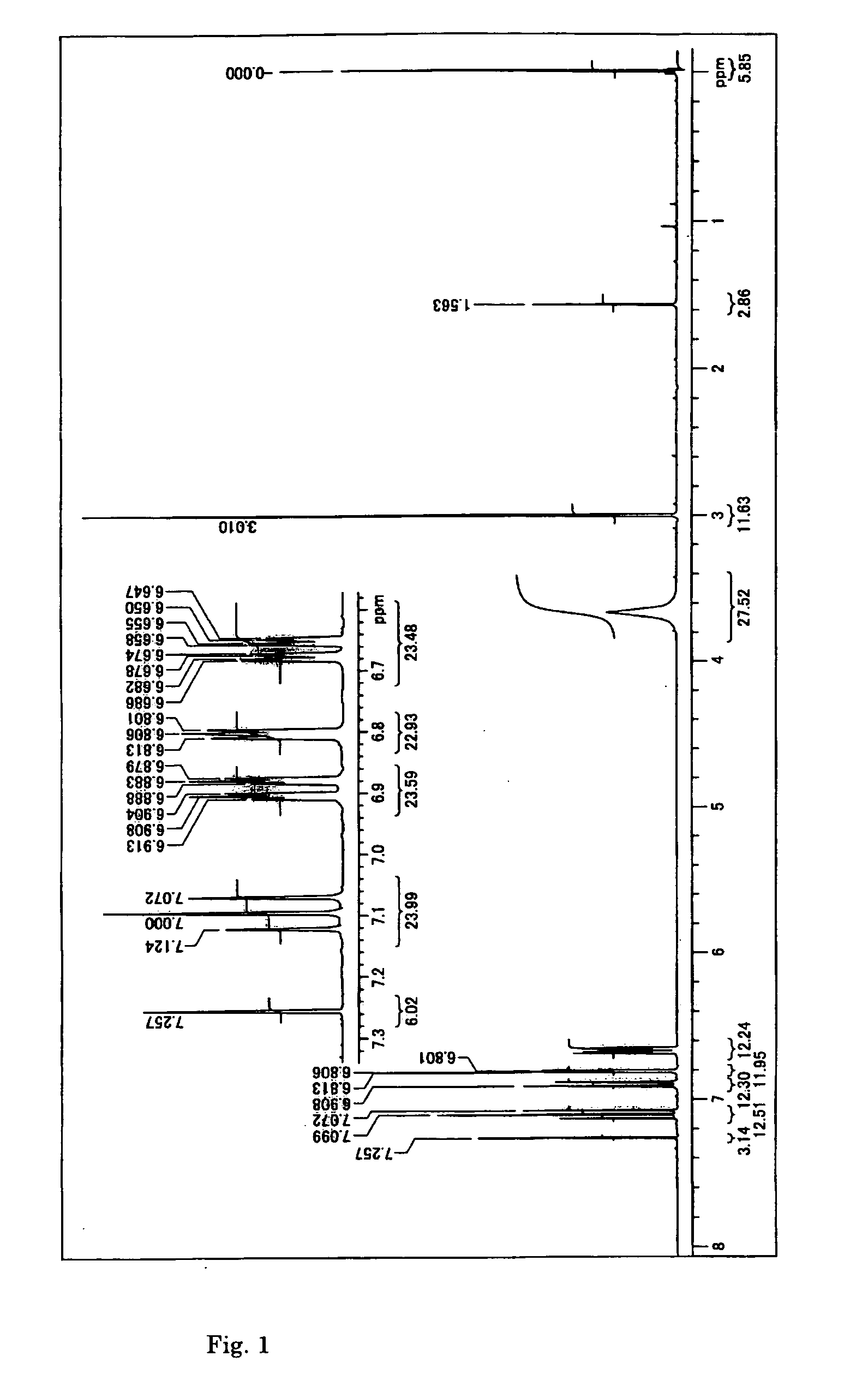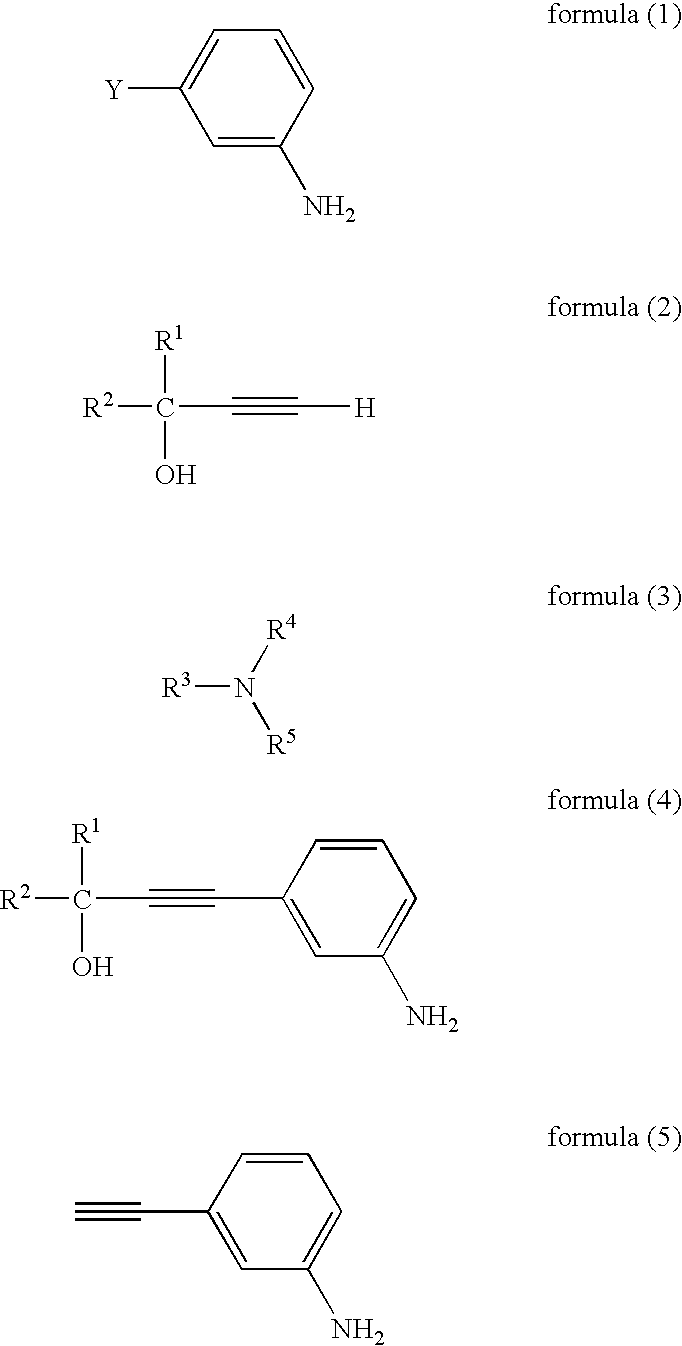Process for preparing 3-aminophenylacetylenes
- Summary
- Abstract
- Description
- Claims
- Application Information
AI Technical Summary
Benefits of technology
Problems solved by technology
Method used
Image
Examples
example 1
(Synthesis of 3-aminophenylacetylene via intermediate 1)
[0111] Synthetic reaction scheme is as follows:
[0112] To a mixture of 3-bromoaniline (172 g), triphenylphosphine (8.5 g), palladium (II) acetate (600 mg), copper (I) iodide (1.2 g), and triethylamine (500 g), 2-methyl-3-butyn-2-ol (100 g) was added dropwise with heating and stirring under reflux conditions. The reaction mixture was stirred for 7 hours, and then, cooled, and the precipitated insoluble components were filtered off. The filtrate was concentrated to obtain a residue. To the residue, 2-propanol (150 ml) and hexane (400 ml) were added, and dissolved with heating. The mixture was then cooled to 20° C. with stirring, and thus, a crystal was precipitated.
[0113] The crystallized solution was cooled to 10° C., and then the crystal was collected by filtration, and washed and dried, resulting in 132 g of an intermediate 1 in the form of a light-brown needle crystal. The yield was 75% based on 3-bromoaniline. The analys...
example 2
(Synthesis of 3-aminophenylacetylene via intermediate 1)
[0126] The synsthetic reaction scheme is the same as described in Example 1.
[0127] A mixture of 3-bromoaniline (172 g), triphenylphosphine (8.5 g), palladium (II) acetate (600 mg), copper (I) iodide (1.2 g), tetra-n-butylammonium bromide (9 g), 2-methyl-3-butyn-2-ol (100 g), and triethylamine (500 g), was stirred under reflux conditions for 6 hours. The reaction mixture was cooled, and then the precipitated insoluble components were filtered off. The filtrate was concentrated, and diluted with ethyl acetate. It was then washed with an aqueous solution of disodium ethylenediaminetetraacetate (EDTA—disodium salt), and then with water, and concentrated. The residue was crystallized from a mixed system of 2-propanol / hexane (volume ratio 1 / 3), and the precipitated crystal was collected by filtration, and washed and dried, resulting in 128 g of an intermediate 1 in the form of a light-brown needle crystal. The yield was 73.1% base...
example 3
(Synthesis of 3-aminophenylacetylene via intermediate 1)
[0132] The synsthetic reaction scheme is the same as described in Example 1.
[0133] The mixture of the intermediate 1 (50 g) synthesized in Example 2, toluene (150 ml), and a sodium hydroxide aqueous solution (sodium hydroxide 5 g / water 50 ml), was heated with stirring under a nitrogen flow at 90° C. for 3 hours. The reaction mixture was cooled to room temperature, and then, the organic layer was collected, and washed with water. Then, toluene was distilled off. The residue was distilled, resulting in 29 g of 3-aminophenylacetylene in the form of a colorless liquid. The yield was 83%.
[0134] The GC purity was 99.0%. The measurement conditions were set to be the same as the measurement conditions described in Example 1.
[0135] Also, various spectrum data were in agreement with the data obtained in Example 1.
[0136] As clear from Examples described above, the process of the present invention does not require the preparation of ...
PUM
| Property | Measurement | Unit |
|---|---|---|
| Temperature | aaaaa | aaaaa |
| Temperature | aaaaa | aaaaa |
| Temperature | aaaaa | aaaaa |
Abstract
Description
Claims
Application Information
 Login to View More
Login to View More - R&D
- Intellectual Property
- Life Sciences
- Materials
- Tech Scout
- Unparalleled Data Quality
- Higher Quality Content
- 60% Fewer Hallucinations
Browse by: Latest US Patents, China's latest patents, Technical Efficacy Thesaurus, Application Domain, Technology Topic, Popular Technical Reports.
© 2025 PatSnap. All rights reserved.Legal|Privacy policy|Modern Slavery Act Transparency Statement|Sitemap|About US| Contact US: help@patsnap.com



